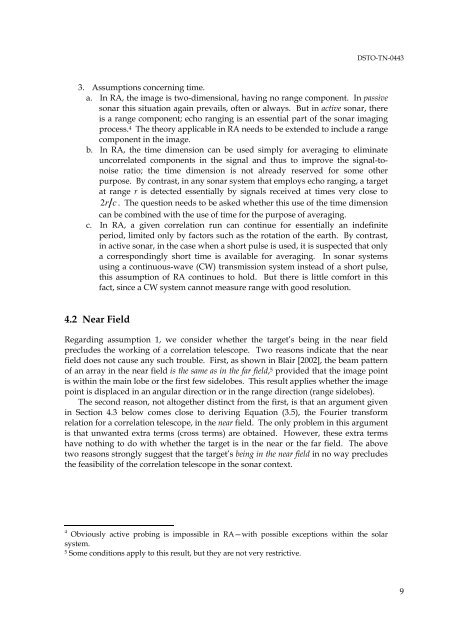Suitability of Correlation Arrays and Superresolution for Minehunting ...
Suitability of Correlation Arrays and Superresolution for Minehunting ...
Suitability of Correlation Arrays and Superresolution for Minehunting ...
Create successful ePaper yourself
Turn your PDF publications into a flip-book with our unique Google optimized e-Paper software.
DSTO-TN-0443<br />
3. Assumptions concerning time.<br />
a. In RA, the image is two-dimensional, having no range component. In passive<br />
sonar this situation again prevails, <strong>of</strong>ten or always. But in active sonar, there<br />
is a range component; echo ranging is an essential part <strong>of</strong> the sonar imaging<br />
process. 4 The theory applicable in RA needs to be extended to include a range<br />
component in the image.<br />
b. In RA, the time dimension can be used simply <strong>for</strong> averaging to eliminate<br />
uncorrelated components in the signal <strong>and</strong> thus to improve the signal-tonoise<br />
ratio; the time dimension is not already reserved <strong>for</strong> some other<br />
purpose. By contrast, in any sonar system that employs echo ranging, a target<br />
at range r is detected essentially by signals received at times very close to<br />
2 r c . The question needs to be asked whether this use <strong>of</strong> the time dimension<br />
can be combined with the use <strong>of</strong> time <strong>for</strong> the purpose <strong>of</strong> averaging.<br />
c. In RA, a given correlation run can continue <strong>for</strong> essentially an indefinite<br />
period, limited only by factors such as the rotation <strong>of</strong> the earth. By contrast,<br />
in active sonar, in the case when a short pulse is used, it is suspected that only<br />
a correspondingly short time is available <strong>for</strong> averaging. In sonar systems<br />
using a continuous-wave (CW) transmission system instead <strong>of</strong> a short pulse,<br />
this assumption <strong>of</strong> RA continues to hold. But there is little com<strong>for</strong>t in this<br />
fact, since a CW system cannot measure range with good resolution.<br />
4.2 Near Field<br />
Regarding assumption 1, we consider whether the target’s being in the near field<br />
precludes the working <strong>of</strong> a correlation telescope. Two reasons indicate that the near<br />
field does not cause any such trouble. First, as shown in Blair [2002], the beam pattern<br />
<strong>of</strong> an array in the near field is the same as in the far field, 5 provided that the image point<br />
is within the main lobe or the first few sidelobes. This result applies whether the image<br />
point is displaced in an angular direction or in the range direction (range sidelobes).<br />
The second reason, not altogether distinct from the first, is that an argument given<br />
in Section 4.3 below comes close to deriving Equation (3.5), the Fourier trans<strong>for</strong>m<br />
relation <strong>for</strong> a correlation telescope, in the near field. The only problem in this argument<br />
is that unwanted extra terms (cross terms) are obtained. However, these extra terms<br />
have nothing to do with whether the target is in the near or the far field. The above<br />
two reasons strongly suggest that the target’s being in the near field in no way precludes<br />
the feasibility <strong>of</strong> the correlation telescope in the sonar context.<br />
4 Obviously active probing is impossible in RA—with possible exceptions within the solar<br />
system.<br />
5 Some conditions apply to this result, but they are not very restrictive.<br />
9

















